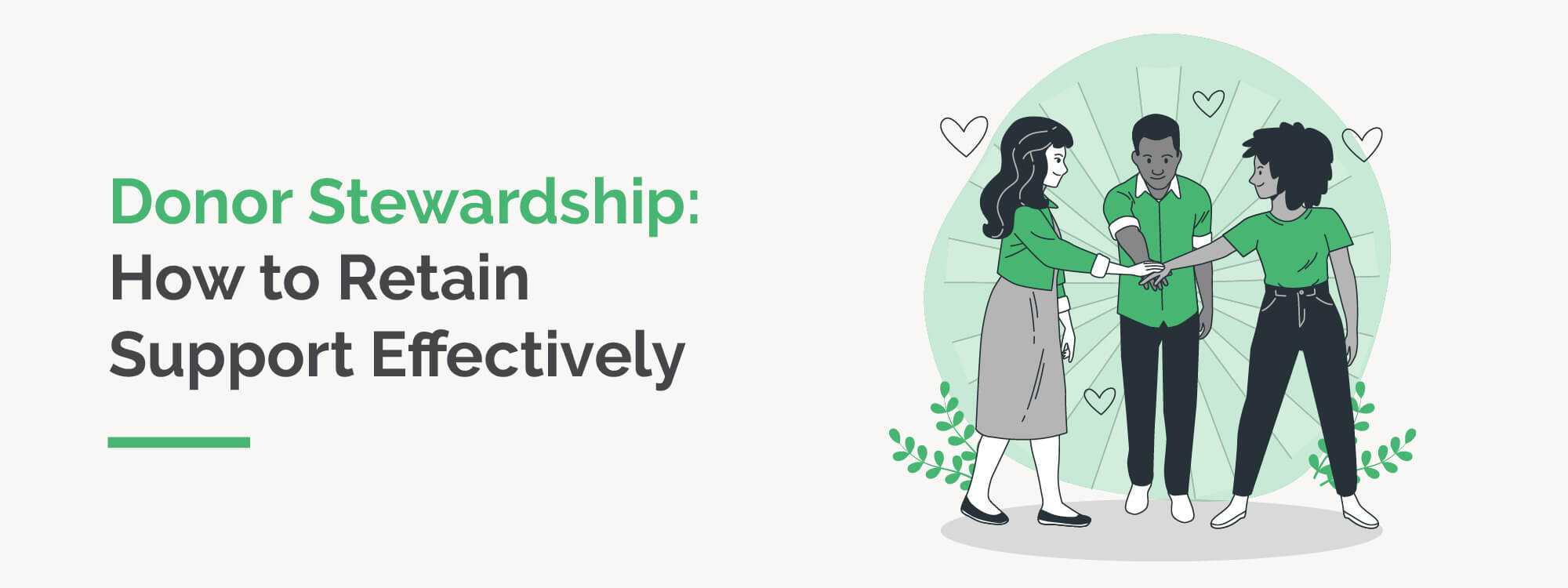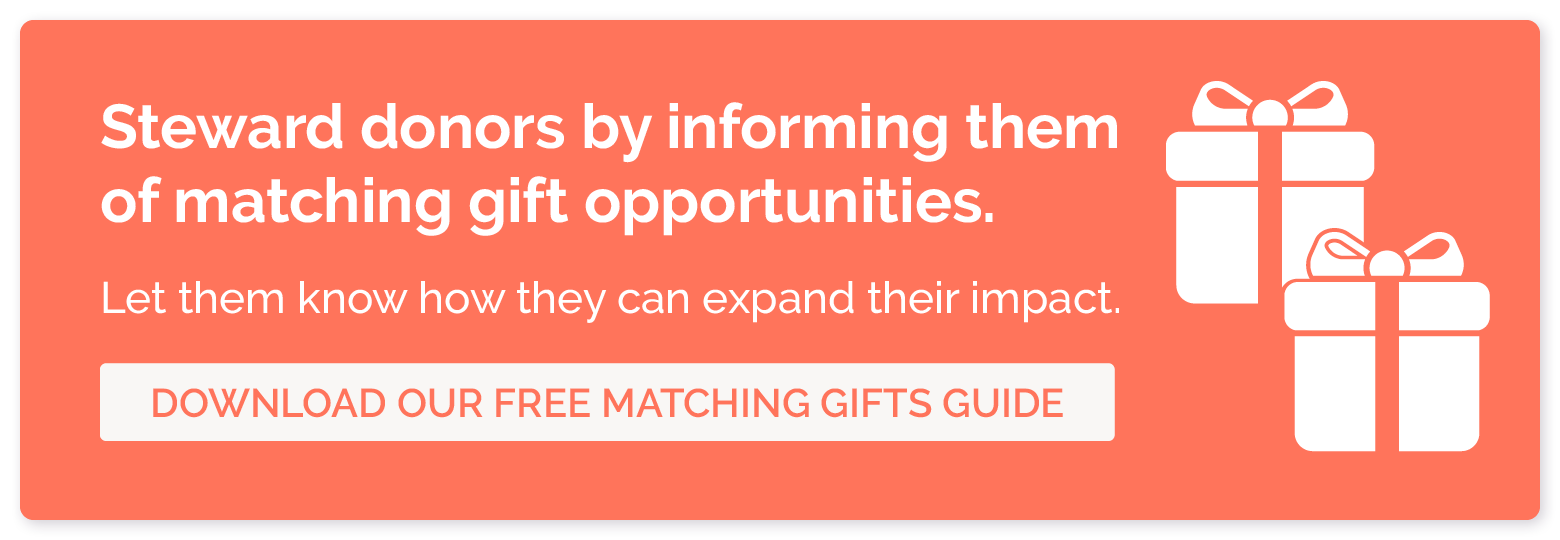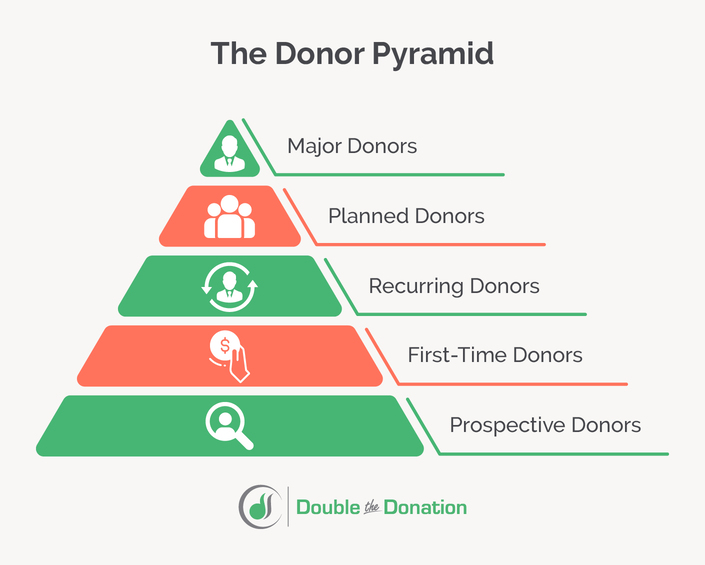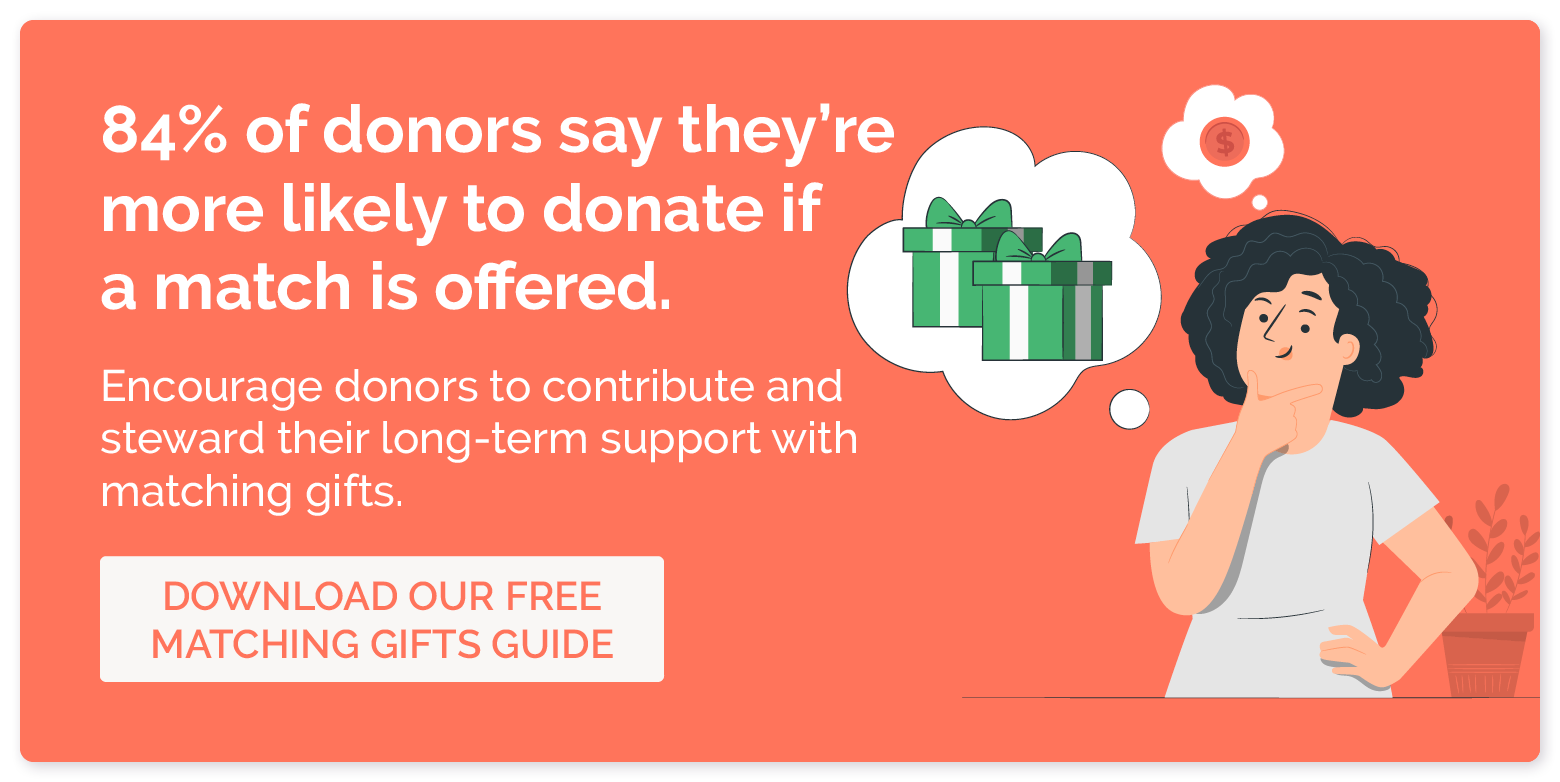Donor Stewardship: How to Retain Support Effectively
According to OneCause’s Fundraising Outlook Report, the percentage of organizations that identify donor retention as a critical priority has decreased from 57% to 51%. While it’s concerning that fewer nonprofits are trying to reduce costs and form lasting relationships by focusing on donor retention, this insight reveals an opportunity to get ahead and stand out from other organizations vying for attention in your sector.
While the average donor retention rate hovers around 40%, there are strategies your organization can implement to increase this number and secure more long-term support. The top way to keep donors coming back is to create a donor stewardship plan.
We’ll help you dive into donor stewardship by reviewing the following topics:
- What is donor stewardship?
- What is the relationship between donor stewardship and retention?
- What is the donor pyramid?
- How does donor stewardship fit into donor cultivation?
- Creating a Donor Stewardship Plan: 5 Steps
With a better understanding of donor stewardship and a dedicated plan, you can make stewardship an ongoing, iterative process at your organization and consistently build enduring donor relationships.
What is donor stewardship?
Donor stewardship is the process of extending a relationship beyond the donor’s gift. The ultimate goal of donor stewardship is to encourage them to give again by building a deeper connection with them. Developing that sense of loyalty will make your fundraising efforts more seamless in the future because you’ll have a strong supporter base to tap into.
For stewardship to be effective, nonprofits must form mutually beneficial relationships with their donors. While nonprofits receive financial support, donors get to feel good about the impact they’ve made and join a community of people passionate about your cause. To create these relationships, nonprofits implement stewardship strategies that keep donors updated on the impact of their gifts and provide them with additional engagement opportunities.
What is the relationship between donor stewardship and retention?
Donor retention is a measure of how many donors come back to contribute to your organization after their initial gift. You can calculate your donor retention rate by dividing the number of donors who gave again this year by the number of donors who contributed last year, then multiplying that number by 100.
In recent years, donor retention has been on the decline, with an overall donor retention rate of 42.6% in 2022, which was 3.5% less than the previous year. There are costs associated with acquiring new donors, and when your donor retention rate is low, your organization has to continuously maximize the time, effort, and resources it pours into donor acquisition.
Donor stewardship helps your organization conserve resources and build a more reliable donor pool. You need regular communication to remind donors of your cause and how vital their support is, and with a dedicated donor stewardship plan, you can keep in contact with donors and ultimately retain them.
Additionally, retained donors are more valuable to your organization because they give more, more often, and are more likely to engage with your nonprofit in other ways. Considering 94% of recurring donors prefer to give to their causes of choice monthly, stewarding these donors enables you to build a consistent community of supporters rather than a sporadic, constantly shifting list of one-time donors.
Lastly, you already have data stored for previous donors in your database or constituent relationship management platform (CRM). You can use this information to reengage and steward these relationships because you know more about their interests and preferences. With a data-driven stewardship approach, you can meet donors where they are and personalize your communications to retain their support.
What is the donor pyramid?
The donor pyramid is a visual representation of different donor giving levels. Since first-time donors are likely your largest donor group, they occupy the bottom of the pyramid whereas the few major donors you have reside at the top. When you understand which category of the pyramid each donor fits into, you can better steward them up the pyramid and increase their support.
The main categories of the donor pyramid include:
- Prospective donors. Some organizations include prospective donors at the bottom of the pyramid to represent all potential giving opportunities. You may omit this group or narrow it down to those who have shown interest in your cause but haven’t yet contributed monetarily, such as volunteers, social media followers, or newsletter subscribers.
- First-time donors. Most nonprofits place first-time donors at the bottom of the pyramid. While these supporters have demonstrated interest in your mission, it’s crucial to follow up with them immediately after their initial gift to show your appreciation and share the impact of their contribution.
- Recurring donors. Recurring donors may give on a monthly, quarterly, annual, or varying basis. You may create different segments for each of these groups and develop stewardship strategies depending on giving frequency.
- Planned donors. Planned donors pledge gifts to be contributed to nonprofits once they pass away. These bequests are typically sizable donations, so it’s important to show your appreciation for planned donors’ contributions.
- Major donors. The top of the pyramid is comprised of major donors who give the largest gifts to your organization. Depending on your nonprofit’s size and typical donation amounts, you may define your major gift threshold differently than other organizations do.
To form your nonprofit’s own donor pyramid, draw supporter insights from your donor database. This information will help you determine which categories to include, roughly how many donors are in each tier, and how to best steward each group to higher levels of the pyramid or larger commitments at their current tier.
How does donor stewardship fit into donor cultivation?
Donor cultivation is the process of acquiring new donors and strengthening relationships with them. While donor stewardship is the last step in the cultivation cycle, it’s important to understand each step in the process and how it informs your stewardship efforts:
1. Identification
The first step in the donor cultivation cycle is to identify potential donors. This step may involve reviewing your CRM for supporters who may be interested in donating, identifying previous or lapsed donors, or conducting outreach to those who are completely new to your organization and mission.
Some strategies for identifying prospective donors include:
- Prospect research. When you’re looking for potential major donors, conducting prospect research can help you determine supporters’ giving capacity and willingness to contribute. That way, you can focus your outreach on those who are most likely to make a major contribution.
- Existing connections. Current supporters and stakeholders in your organization can help you identify people in their networks who may be interested in contributing to your cause. Ask your board members, major donors, and staff if they have any connections they can leverage.
- Surveys. Sometimes the best way to identify if someone would be interested in giving is to simply ask them. Send surveys to your supporter base asking them if they’re open to making a monetary contribution and what type of gift they would like to make.
In this stage, it’s important to emphasize your nonprofit’s mission and let potential donors know the impact their contributions could make.
2. Qualification
Now that you’ve identified potential donors, it’s time to narrow down that list further to prioritize those with the highest giving likelihood. Some factors you may assess to determine the most qualified potential donors are:
- Previous engagement. Potential donors may have interacted with your organization in ways other than donating, such as attending an event, volunteering, following your social media accounts, or signing up for your newsletter. These interactions demonstrate potential donors’ interest in your nonprofit and may indicate their likelihood to donate.
- Wealth markers. Identifying potential donors’ capacity to give is especially useful for determining who may become a major donor. These wealth indicators may include real estate ownership, stock holdings, and business affiliations.
- Affinity markers. Just because someone has the capacity to give doesn’t mean they’re interested in contributing. Affinity markers such as political involvement and previous support for other charitable causes allow you to assess the alignment between a potential donor’s values and your organization’s mission.
While some of this information may be stored in your CRM or found in public records, it can be helpful to work with a fundraising consultant or data provider who can acquire this data for you.
3. Cultivation
The cultivation step involves laying the foundation for a long-term relationship with prospects. Before soliciting a donation, introduce potential donors to your organization and invite them to get involved with:
- Educational materials. Allow prospects to learn more about your mission and work by providing them with educational materials. Send them introductory pamphlets, videos of your beneficiaries, and summaries of your services so they can become more familiar with your organization.
- Volunteer opportunities. When prospects volunteer with your nonprofit, they’ll receive hands-on experience with your cause. As a result, they may develop a connection to your mission and be more open to donating.
- Events. An event is a perfect opportunity for prospects to meet current donors and find out why they support your cause. Consider inviting prospects to your next fundraising or advocacy event so they can become immersed in your community and determine if they’d like to become more involved.
Personalizing your communications with prospects is also a powerful strategy for developing relationships with them. Use data from your CRM to learn more about your prospects and tailor your communications accordingly. For example, if a prospect recently volunteered with your nonprofit, thank them for their support and follow up with additional volunteer opportunities they may be interested in.
4. Solicitation
After getting to know potential donors and informing them about your organization, you can begin soliciting donations. When making your initial asks, keep these tips in mind:
- Be specific. Using the data you’ve gathered about your prospects, suggest a specific donation amount that aligns with their giving capacity. You should also be clear about what that amount of money will allow your nonprofit to accomplish. For example, an animal shelter might specify that a $100 donation allows it to restock its pet food supply for one week.
- Appeal to prospects’ emotions. Don’t be afraid to use emotionally charged language to show prospects why they should care about your cause and how they have the power to make an impact. Including a testimonial from a beneficiary or current donor can help make a prospect’s potential impact more tangible.
- Mention matching gift opportunities. Did you know that 84% of people say they’re more likely to donate if a match is offered, and 1 in 3 donors claim they’d give a larger gift if matching is applied to their donation? Informing prospects about matching gift opportunities in your ask can motivate them to donate and allow you to gain even more for your cause. Matching gifts occur when a company matches their employees’ donations to a nonprofit, usually at a 1:1 ratio. As a result, your nonprofit can double its donation revenue. Learn best practices for promoting matching gifts in the video below:
As the video states, raising awareness for matching gifts is key. Once potential donors know about the power of matching gifts, you can make the process easier by researching their eligibility for them or providing them with a matching gift database where they can easily find their employer’s matching gift policies.
If a prospect says “no” to your first ask, that doesn’t mean you’ve failed to garner their support. Continue cultivating a relationship with this individual until it’s appropriate to make another donation request. Even if they don’t end up contributing monetarily, they can still become an active member of your community by volunteering, attending events, and engaging with your content online.
5. Stewardship
You should begin the donor stewardship process immediately after a prospect becomes a donor. Follow these steps to kick off your stewardship efforts:
- Thank donors for their support. Show donors your appreciation for their contributions. To quickly and efficiently thank donors, automate a thank-you eCard to be sent to each donor right after they submit their donation. For larger gifts, you may send a handwritten thank-you note or call major donors to demonstrate your appreciation.
- Recognize your donors. Larger gifts may also warrant public recognition of your donors through plaques, donor appreciation events, or invitations to your nonprofit’s giving society. You can also recognize mid-level donors by creating social media or newsletter spotlights.
- Report on their impact. No matter the size of their donation, donors want to know that your organization is using their funds responsibly. Update donors on the specific initiatives you’ve allocated their donations toward, whether that’s a new program, supplies, a fundraising event, or something else entirely.
While these steps are a great start to donor stewardship, you’ll need a dedicated stewardship plan to effectively sustain your relationships with donors.
Creating a Donor Stewardship Plan: 5 Steps
A systematic approach to donor stewardship ensures no donor gets left behind and that your team knows exactly how to uphold donor relationships. To create a donor stewardship plan, follow these essential steps:
1. Determine your donor stewardship goals.
The beginning of any plan should start with goal creation, and donor stewardship is no different. Goals developed using the SMART (Specific, Measurable, Achievable, Relevant, and Time-Bound) goal framework allow you to measure the success of your stewardship plan more easily.
For example, your nonprofit may want to grow its recurring giving program. Here’s how your team could incorporate each element of the SMART goal framework into your objectives:
- Specific. Our fundraising team will reach out to first-time donors to introduce them to the recurring donor program and demonstrate how recurring gifts will maximize their impact.
- Measurable. Our goal is to convert 20% of first-time donors into recurring donors.
- Achievable. Considering 57% of donors are enrolled in a recurring giving program, and we had 10% of last year’s first-time donors become recurring donors, this is a challenging yet realistic goal.
- Relevant. Growing our recurring donor program will allow us to develop a more consistent revenue stream for our nonprofit, empowering us to better serve our beneficiaries and fulfill our mission.
- Time-Bound. Our goal is to convert these donors to recurring donors by the end of the year. We will start communicating with first-time donors next week and track monthly progress.
Other common goals may include increasing your donor retention rate, bolstering your major gift fundraising, or improving your post-event outreach. No matter what your goals are, setting clear objectives allows your team to stay on track and create progress benchmarks so you can make adjustments as needed.
2. Segment your donors.
While reaching out to each donor individually would be ideal for stewardship, it’s often unfeasible. When you segment your donors into relevant groups, you can personalize the donor stewardship process more efficiently.
Common ways to segment donors include grouping by:
- Donation amount
- Donation frequency
- Donation recency
- Engagement level
- Communication preferences
- Demographics
Then, you can reach out to each group with communications and engagement opportunities that they’ll resonate with. For example, you may create a special newsletter for monthly donors that lets them know about upcoming events and volunteer outings happening each month.
3. Develop an outreach cadence.
Using your segments, create an automated outreach cadence that keeps donors’ shared characteristics in mind. New donors should receive more in-depth information about your organization and mission that they may not have received in the initial cultivation process. Then, you can automate more specific communications to your segments to streamline your donor stewardship.
By integrating your email marketing software and your donor database, you can create personalized campaigns depending on donors’ interests and current stages in the stewardship process. For instance, during the cultivation stage, you may send prospects within a ten-mile radius of your organization’s headquarters information about in-person events and engagement opportunities in their community.
4. Offer additional engagement opportunities.
To maintain relationships with donors, you’ll need to offer engagement opportunities other than simply donating. While you may already have general fundraising events and volunteer opportunities planned, take the time to develop additional opportunities for donors to engage with your cause, such as:
- Cause-related workshops and speaker sessions
- Meetings with beneficiaries
- Tours of your facility
- Exclusive major donor events
- Fundraising event planning committees
When you share activities with your donors that are unaccompanied by a donation ask, you prove to donors that you’re committed to providing them with a positive experience with your nonprofit. Through a variety of engagement opportunities, you can build a strong community of supporters and advocates for your cause.
5. Collect feedback.
You can (and should) measure progress using the key performance indicators (KPIs) and goals you identified early on in the stewardship process. However, qualitative data in the form of donor feedback can give you insight into what your donors enjoy about your stewardship efforts and what your team could improve.
Send regular surveys to your donors to gather feedback about your donor stewardship plan. The questions you may ask include:
- How often would you like our nonprofit to communicate with you?
- Is our current communication frequency too little, too much, or the right amount?
- What engagement opportunities have you most enjoyed?
- What additional engagement opportunities would you like to see offered?
- Is there anything else our nonprofit can do to improve your experience with us?
Analyze donors’ responses with your team to glean any insights you can apply to your donor stewardship plan. For donors with multiple ideas or many points of feedback, consider calling them to hear more about their experience and gain an even more in-depth understanding of your stewardship efforts’ efficacy.
Wrapping Up
With a comprehensive donor stewardship plan, your nonprofit can build strong donor relationships, increase donor retention, and earn more for your cause. Whether you’re trying to grow your recurring donor program, acquire more major donors, or follow up with event attendees more effectively, a dedicated plan will assist you in reaching your goals and stewarding donors to higher levels of the donor pyramid.
To learn more about elements of the donor stewardship process, check out these resources:
- Donor Retention: A Comprehensive Guide + 6 Strategies. Donor retention is the driving force behind donor stewardship. Learn more about how to calculate donor retention and why it’s important.
- Nonprofit Basics: The Donor Pyramid. When you develop a donor pyramid, you can more easily steward donors to higher engagement levels. This guide presents tips for how to personalize your donor pyramid to your organization.
- Donor Recognition: When & How to Acknowledge Supporters. Recognizing your donors allows you to show your appreciation and strengthen your relationships with them. Dive deeper into donor recognition strategies with this guide.








